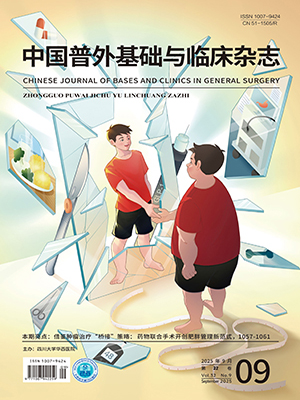| 1. |
Ongaro E, Buoro V, Cinausero M, et al. Sarcopenia in gastric cancer: when the loss costs too much. Gastric Cancer, 2017, 20(4): 563-572.
|
| 2. |
Haiducu C, Buzea A, Mirea LE, et al. The prevalence and the impact of sarcopenia in digestive cancers. A systematic review. Rom J Intern Med, 2021, 59(4): 328-344.
|
| 3. |
张才华, 刘鹏鹏, 龚龙波, 等. 构建基于营养风险和肌肉减少症评估的列线图预测老年胃癌患者根治性切除术后并发症. 中国普外基础与临床杂志, 2023, 30(4): 431-436.
|
| 4. |
夏德鑫, 左君波, 严玉兰, 等 . 肌少症对胃癌患者术后早期临床预后的影响. 实用临床医药杂志, 2023, 27(9): 65-70.
|
| 5. |
中国抗癌协会肿瘤营养专业委员会, 崔久嵬, 卓文磊, 等. 肿瘤免疫营养治疗指南. 肿瘤代谢与营养电子杂志, 2020, 7(2): 160-168.
|
| 6. |
Chew STH, Kayambu G, Lew CCH, et al. Singapore multidisciplinary consensus recommendations on muscle health in older adults: assessment and multimodal targeted intervention across the continuum of care. BMC Geriatr, 2021, 21(1): 314. doi: 10.1186/s12877-021-02240-8.
|
| 7. |
刘娟, 丁清清, 周白瑜, 等. 中国老年人肌少症诊疗专家共识(2021). 中华老年医学杂志, 2021, 40(8): 943-952.
|
| 8. |
Couderc AL, Liuu E, Boudou-Rouquette P, et al. Pre-therapeutic sarcopenia among cancer patients: an up-to-date meta-analysis of prevalence and predictive value during cancer treatment. Nutrients, 2023, 15(5): 1193. doi: 10.3390/nu15051193.
|
| 9. |
Cruz-Jentoft AJ, Bahat G, Bauer J, et al. Sarcopenia: revised European consensus on definition and diagnosis. Age Ageing, 2019, 48(4): 601. doi: 10.1093/ageing/afz046.
|
| 10. |
Rinninella E, Cintoni M, Raoul P, et al. Muscle mass, assessed at diagnosis by L3-CT scan as a prognostic marker of clinical outcomes in patients with gastric cancer: a systematic review and meta-analysis. Clin Nutr, 2020, 39(7): 2045-2054.
|
| 11. |
陆金玲, 许勤, 陈丽, 等. 5 种肌肉减少症筛查工具在胃癌患者术前营养评定中的应用比较. 中华护理杂志, 2021, 56(9): 1299-1304.
|
| 12. |
Ding L, Wang X, Mao T, et al. Diagnostic value of serum creatinine and cystatin-C-based indices and Ishii score in cancer-related sarcopenia. Diagnostics (Basel), 2023, 13(13): 2179. doi: 10.3390/diagnostics13132179.
|
| 13. |
孙慧, 徐慧, 陆滢滢, 等. 营养风险筛查工具识别胃癌患者肌减少症的临床价值. 实用临床医药杂志, 2023, 27(2): 78-83.
|
| 14. |
高彩艳, 张树泽, 曹宏泰, 等. 肌少症在胃癌患者中的研究进展. 中华普通外科学文献(电子版), 2022, 16(4): 302-307.
|
| 15. |
Chen X, Cao M, Liu M, et al. Association between sarcopenia and cognitive impairment in the older people: a meta-analysis. Eur Geriatr Med, 2022, 13(4): 771-787.
|
| 16. |
张颖, 陈柯雅, 张维, 等. 胃癌患者肌少症风险筛查和评估的最佳证据总结. 中华现代护理杂志, 2024, 30(10): 1261-1267.
|
| 17. |
Hirahara N, Tajima Y, Fujii Y, et al. Prediction of postoperative complications and survival after laparoscopic gastrectomy using preoperative Geriatric Nutritional Risk Index in elderly gastric cancer patients. Surg Endosc, 2021, 35(3): 1202-1209.
|
| 18. |
吴寒寒, 蒋建华, 程靖, 等. 老年营养风险指数与老年胃癌患者围手术期康复的关系. 安徽医科大学学报, 2022, 57(11): 1816-1820.
|
| 19. |
李燕, 朱慧娣. 胃癌合并肌少症患者评估及干预的研究进展. 加速康复外科杂志, 2023, 6(4): 164-169.
|
| 20. |
唐欢, 李娟, 余欢, 等. 肌少症患者肌肉质量测评工具的研究进展. 中国骨质疏松杂志, 2023, 29(1): 129-133.
|
| 21. |
王晓琳, 宋世明. 恶性肿瘤患者相位角与肌肉质量的相关性研究. 中国医学前沿杂志(电子版), 2023, 15(6): 27-33.
|
| 22. |
吴佳佳, 邢学农. 肌少症研究进展. 医学综述, 2016, 22(4): 753-756.
|




